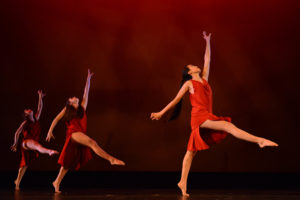By Abigail Sokolsky || Layout Assistant

This past week the F&M Dance Company performed in works by Lori Belilove/Isadora Duncan, Jennifer Conley, Megan Curet, Martha Graham, Elba Hevia y Vaca, and Pamela Vail in the 2017 Fall Dance Concert. It was a treat for all the folk music lovers. Before the curtain opened, the performance was dedicated to Professor Lynn Matluck Brooks for her accomplishments throughout her career at F&M as well as her assistance with the creation of two of the dances: Pandora and the Furies and Panorama.
Professor Brooks has been a professor at F&M since the founding of the F&M Dance Program in 1984 and will be retiring in the following year.
The concert then began with a performance of Panorama, choreographed and costumed by Martha Graham. This piece originally premiered on August 14, 1935 at the Vermont State Armory in Bennington, Vermont. The concert program included an original program note from 1935 explaining the dance’s intended focus on the imperial, noting that “In every country there are basic themes of thought and action. These themes are part of the national consciousness and form an inheritance which contributes to the present. Panorama endeavors to present three themes which are basically American.” This piece additionally included a large hanging mobile designed after Alexander Calder by students in ART230, Papermaking and Casting, under the direction of Professor Virginia Maksymowicz and Jason Thompson.
The next two performances were titled Troubling the Waters and New Order. Troubling the Waters featured flowing movement and Spanish music, juxtaposing lively movement and moments of silence during short transitions. The end of this piece included a spoken component, the dancers repeating “everything’s alright- yes” in what begins as a statement but becomes a question. The following piece, New Order, was a contrast in that it was more modern. Dancers appeared on stage in jeans in a group, continuing to alternately leave and join the group and perform pulse-like movements.
The following dance was The Traveling Tribe of the Wrinkled Skirts, a dance aptly named for the wrinkled two-paneled black skirts which the three dancers onstage wore. This dance was performed to the pounding of deep drums, conveying intensity and strength as the dancer’s each took turns as the central dancer, which the other two responded to. This dance, musically and through movement, was a combination of modern and tribal elements, additionally conveying an underlying tone of female strength.
It is therefore appropriate that the proceeding dance, Pandora and the Furies, described in the program in a note from Lori Belilove, as “a powerful, grounded expression of female fury,” a dance similarly dealing with the raw vitality of women through the Greek myth of Pandora releasing evil upon the world. This visual depiction of a classic Greek myth included boldly clad dancers in red who evoked the imagery of furies through hand movement, extending fingers with a talon-like stiffness.
Next came Ritmo Unido, a dance which once again used a prop onstage. Just as Pandora and the Furies incorporated a Pandora figure carrying a box, this dance incorporated a water bowl. As the dancers mimed working under the hot sun, periodically they would approach a bowl filled with water onstage, revitalizing the dance before movements became more frantic under the oppressive heat once again. A leaf-like lighting pattern as a backdrop combined with tropical music enforced the image of a hot climate.
The final piece of the concert Casting Light also used objects on stage in the form of hanging lightbulbs which the dancers turned on and off. This piece was by far the most visually stunning of the concert with its bright lights and gliding steps. As the dancers stretched out on the floor as if to sleep, the lights were extinguished one by one, ending the performance on a strong note.
Junior Abigail Sokolsky is a layout assistant. Her email is asokolsk@fandm.edu.